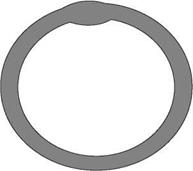In a precision medical application the quantity to be dispensed might be less than a milligram of adhesive but for a seal around a solar panel, the quantity could be several grams and it is unlikely that the same piece of dispense equipment will be suitable for both applications. The positional accuracy of the adhesive may also be a significant factor when selecting an adhesive dispensing system. In these situations, an investment in a three-axis, four-axis or six-axis robot may be necessary but sometimes well-engineered jigs can significantly assist the operator at the dispensing station.
One of the issues typically encountered when dispensing a bead of high viscosity adhesive is the ‘dog bone’ effect, whereby the bead of adhesive is not consistent along its length but often has a higher ‘blob’ at each end (Figure 8.2).
The reason for this is when an adhesive is dispensed at high pressure, there is a pressure surge as the valve opens causing excess adhesive to flow. This quickly disappears as the flow rate steadies but at the end of the bead as the valve closes some adhesive can be pushed forward.
Careful valve design and robot programming can minimise these effects but it is always difficult to join a bead to create a continuous seal and totally eliminate the ‘knit’ point in the bead (Figure 8.3).
One possible method for minimising the ‘knit joint’ is to design the groove in the component to allow for a small surge of adhesive and include a run-in or run-out point (Figures 8.4 and 8.5).
In Figure 8.5, the design allows for the ‘start-stop’ point of the adhesive bead thus minimising the effect of the ‘knit’ joint.
|
Figure 8.3 Minimising the effect of the ‘knit’ joint in a closed bead can be difficult to achieve even on a robot |
Figure 8.5 Groove has been altered to allow for dispensing of adhesive
 15 декабря, 2015
15 декабря, 2015  Pokraskin
Pokraskin 
 Опубликовано в рубрике
Опубликовано в рубрике 